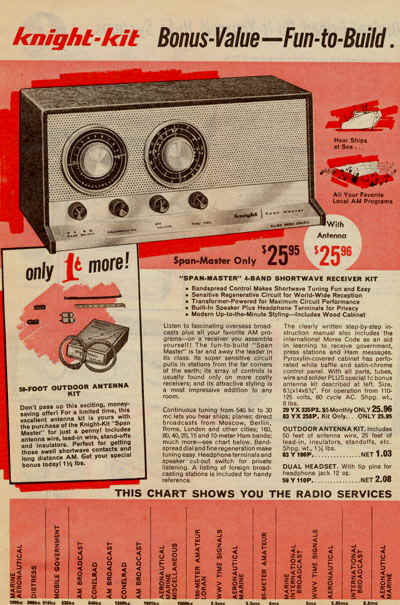Welcome to Handiham World.
What got you started in radio?
When I think about that question, I recall a little crystal radio kit that my dad bought for me. It had a plastic housing to make it look like a real table radio, except that it was smaller and had only a single earpiece. And of course it "magically" took a radio signal right out of the airwaves and turned it into music without any electricity at all! It was one of several crystal diode radios that I had as a kid. Another memorable one was made up in a round plastic ball that was supposed to be a satellite. There was a tuning control that consisted of a slug-tuned coil. The brass screw from the ferrite slug extended out of the top of the "satellite" like some sort of antenna. It had a little rubber cap on it to serve as a grip, so that the coil could be tuned more easily. The real antenna was a piece of bell wire with an alligator clip at the end. That allowed you to connect the radio to something conductive that might hopefully act as a better antenna and bring in a local AM station. Of course today the term "satellite radio" means something completely different!
When I was a teenager, dad bought me a Knight-Kit Span Master two tube regenerative receiver. It was not my brightest moment in radio when the kit manual called for putting "spaghetti" over some of the bare wire leads during assembly and I went down to the kitchen cabinet to find this apparently necessary but odd ingredient for a radio. Dad straightened me out on that and we ended up using the insulating tubing that was actually already provided by Knight-Kit.

Image: Here is the Knight-Kit Span Master as shown in a 1962 Allied Radio catalog. You could get the outdoor antenna kit for only 1 cent more, but the radio itself cost $25.95.
The Span Master worked when it was finished, so I installed it in the vinyl-covered wooden cabinet that came with it and ran a wire out of my bedroom window to serve as an antenna. The circuit might not seem like much, since it had only two vacuum tubes, but it turned out to be light-years ahead of the crystal radios. One important feature was a speaker, so I didn't have to use headphones. The tuning knob was connected directly to a variable capacitor, but there was a helpful bandspread knob connected to a second capacitor so that fine tuning was possible without pulleys and dial strings. Furthermore, the radio had a band switch and covered not only the AM broadcast band but also several short-wave bands. In spite of the two tube design, a fair amount of gain could be had from the simple regenerative circuit. It was also possible to hear Morse code and even something that was new and mysterious back then: SSB. You had to be patient and careful tuning it in, though. It was more fun to listen to far off short-wave stations and find out what was happening all around the world.
I consider the Span Master to have been the radio that really got me interested in getting my amateur radio Novice license. Today we can still find electronic kits, and who knows? One of those kits might spark the interest of a future engineer, scientist, or teacher! Consider an electronic kit as a gift for your child, making it age-appropriate, of course. Then make it a parent-child project to assemble it and make it work. You will both have fun, and open the door to STEM: Science, Technology, Engineering, and Math.
Next week: Thoughts about a broken water pipe.
For Handiham World, I'm...